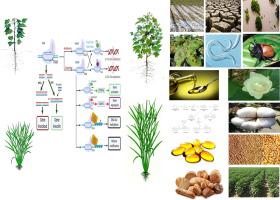Journal of Advanced Research ( IF 10.7 ) Pub Date : 2020-10-21 , DOI: 10.1016/j.jare.2020.10.003 Dangquan Zhang 1 , Zhiyong Zhang 2 , Turgay Unver 3 , Baohong Zhang 4

|
Background
It is a long-standing goal of scientists and breeders to precisely control a gene for studying its function as well as improving crop yield, quality, and tolerance to various environmental stresses. The discovery and modification of CRISPR/Cas system, a nature-occurred gene editing tool, opens an era for studying gene function and precision crop breeding.
Aim of Review
In this review, we first introduce the brief history of CRISPR/Cas discovery followed the mechanism and application of CRISPR/Cas system on gene function study and crop improvement. Currently, CRISPR/Cas genome editing has been becoming a mature cutting-edge biotechnological tool for crop improvement that already used in many different traits in crops, including pathogen resistance, abiotic tolerance, plant development and morphology and even secondary metabolism and fiber development. Finally, we point out the major issues associating with CRISPR/Cas system and the future research directions.
Key Scientific Concepts of Review: CRISPR/Cas9 system is a robust and powerful biotechnological tool for targeting an individual DNA and RNA sequence in the genome. It can be used to target a sequence for gene knockin, knockout and replacement as well as monitoring and regulating gene expression at the genome and epigenome levels by binding a specific sequence. Agrobacterium-mediated method is still the major and efficient method for delivering CRISPR/Cas regents into targeted plant cells. However, other delivery methods, such as virus-mediated method, have been developed and enhanced the application potentials of CRISPR/Cas9-based crop improvement. PAM requirement offers the CRISPR/Cas9-targted genetic loci and also limits the application of CRISPR/Cas9. Discovering new Cas proteins and modifying current Cas enzymes play an important role in CRISPR/Cas9-based genome editing. Developing a better CRISPR/Cas9 system, including the delivery system and the methods eliminating off-target effects, and finding key/master genes for controlling crop growth and development is two major directions for CRISPR/Cas9-based crop improvement.
中文翻译:

CRISPR/Cas:基因功能研究和作物改良的强大工具
背景
精确控制基因以研究其功能以及提高作物产量、品质和对各种环境胁迫的耐受性是科学家和育种者的长期目标。天然存在的基因编辑工具CRISPR/Cas系统的发现和改造,开启了研究基因功能和精准作物育种的时代。
审查目的
在这篇综述中,我们首先介绍了CRISPR/Cas发现的简史,以及CRISPR/Cas系统在基因功能研究和作物改良方面的机制和应用。目前,CRISPR/Cas基因组编辑已成为一种成熟的作物改良前沿生物技术工具,已应用于作物的许多不同性状,包括病原体抗性、非生物耐受性、植物发育和形态,甚至次生代谢和纤维发育。最后,我们指出了CRISPR/Cas系统的主要问题和未来的研究方向。
回顾的关键科学概念: CRISPR/Cas9 系统是一种强大而强大的生物技术工具,用于靶向基因组中的单个 DNA 和 RNA 序列。它可用于靶向序列进行基因敲入、敲除和替换,以及通过结合特定序列在基因组和表观基因组水平上监测和调节基因表达。农杆菌介导的方法仍然是将CRISPR/Cas试剂递送至目标植物细胞的主要且有效的方法。然而,其他递送方法,例如病毒介导的方法,已经被开发出来并增强了基于 CRISPR/Cas9 的作物改良的应用潜力。PAM 要求提供了 CRISPR/Cas9 靶向的基因位点,但也限制了 CRISPR/Cas9 的应用。发现新的 Cas 蛋白和修饰现有的 Cas 酶在基于 CRISPR/Cas9 的基因组编辑中发挥着重要作用。开发更好的CRISPR/Cas9系统,包括递送系统和消除脱靶效应的方法,以及寻找控制作物生长发育的关键/主基因是基于CRISPR/Cas9的作物改良的两个主要方向。



























 京公网安备 11010802027423号
京公网安备 11010802027423号